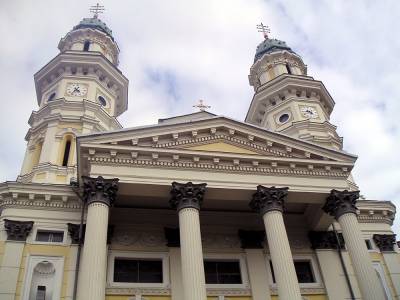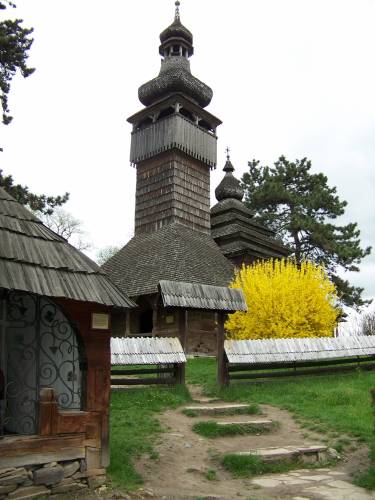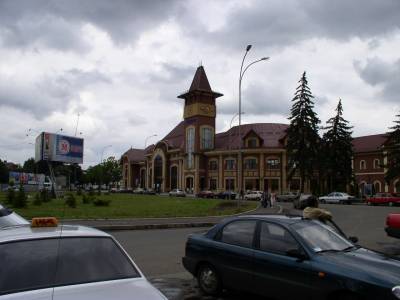
Uzhhorod or Uzhgorod (Ukrainian and Russian: Ужгород; Rusyn: Уґоград, Ужгород or Унґвар; Hungarian: Ungvár; Romani Ungvara; Slovak and Czech: Užhorod; Polish: Użgorod; German: Ungwar, Ungarisch Burg; Yiddish: אונגװיר , translit. Ungver or Ingver, Romanian: Ujgorod) is a city located in western Ukraine, at the border with Slovakia and near the border with Hungary. It is the administrative center of the Zakarpattia Oblast (region), as well as the administrative center of the surrounding Uzhhorodskyi Raion (district) within the oblast. The city itself is also designated as its own separate raion within the oblast.
The city gets its name from the Uzh River, which divides the city into two halves (the old and new sections). Uzh (Уж) means ringed snake (Natrix natrix), and horod (город) is Ruthenian for city, coming from Old Slavonic grad (градъ). However, this name is a recent construct, and has been used only since the beginning of the 20th century. Before then, the city was known as Ungvar, also spelled Ongvar, Hungvar, and Unguyvar. The city's name is spelled Ужгород in both Ukrainian and Russian, transliterated "Uzhhorod" from Ukrainian, "Uzhgorod" from Russian. Until the end of the 20th century, the city was known in English as Uzhgorod. Uzhhorod is located at 48°37′N 22°18′E / 48.617°N 22.3°E / 48.617; 22.3. Its population in 2004 was 111,300. History
Early History The best known of the first city founders are early Slavs. One of their tribes – White Croats – settled the area of the modern Uzhhorod in the second half of the first millennium AD. During the 9th century a fortified castle changed into a fortified early feudal town-settlement, which became the centre of a new Slavonic principality, at the head of which was a legendary prince Laborets, who was vassal of Great Moravia. In 903 AD Hungarian tribes, headed by their leader Árpád, stormed the Hungvar fortress. The forces were not equal and Laborets was defeated and beheaded on the banks of the river that still carries his name. After the arrival of the Hungarians, the small town began to extend its borders. In 1241–1242 the Tatars of Batu Khan burnt the settlement. In the early 14th century Uzhhorod showed strong resistance to the new Hungarian rulers of the Anjou dynasty. From 1318 for 360 years, the Drugeths (Italian counts) owned the town. During that period Philip Drugeth built Uzhhorod Castle. Together with the castle the city began to grow. By 1430, Uzhhorod acquired some privileges from the king and was officially called "The Privileged City of Ungvar" and became capital of Ung County.
Greek Catholic Cathedral in Uzhhorod

During the 16–17th centuries there were many handicraft corporations in Uzhhorod. In this period the city was engaged in the religious fight between primarily Protestant Transylvania and Catholic Austria. In 1646 the Uzhhorod Union was proclaimed and the Greek-Catholic church was established in Subcarpathia, in a ceremony held in the Uzhhorod castle by the Vatican Aegis. In 1707 Uzhhorod was the residence of Ferenc II Rákóczi, the leader of the national-liberation war of the Hungarian people. The beginning of the 19th century was characterized by economic changes, including the first factories in the city. The greatest influence on Uzhhorod among the political events of the 19th century was made by the Hungarian Revolution of 1848-1849 , during which the native Hungarian nobility sought both get free of the Austrian Empire and to assert their right to dominate all other peoples of Hungary. March 27, 1848 was officially celebrated in the city as the overthrow of the monarchy in Hungary. In 1872 the first railway line opened, linking the city to the important railway junction of Chop.
Twentieth century According to the 1910 census, the city had 16,919 inhabitants, of which 13,590 (80.3%) were Hungarians,1,219 (7.2%) Slovakians, 1,151 (6.8%) Germans, 641 (3.8%) Rusyns and 1.6% Czechs. In the same time, the municipal area of the city had a population composed of 10,541 (39.05%) Hungarians, 9,908 (36.71%) Slovaks, and 5,520 (20.45%) Rusyns. The First World War slowed down the tempo of city development. On September 10, 1919 Subcarpathia was officially annexed to the Republic of Czechoslovakia. Uzhhorod became the administrative center of the territory. During these years Uzhhorod developed into an architecturally modern city. After the Munich Treaty Uzhhorod became part of the Slovak half of the new Czecho-Slovak state.
Uzhhorod's former synagogue, now the Philharmonic Orchestra.
Bercsényi Palace in Uzhhorod Castle.
Old Wooden Church in Museum of Folk Architecture.

After the Vienna Award in 1938 Uzhhorod was transferred to Hungary. Until the end of 1944 the fights of the Second World War came close to Uzhhorod. Three days after the Germans occupied Hungary (March 19, 1944), a half dozen trucks loaded with men entered Uzhhorod. At the end of March, the Jewish community was ordered to hand over to the Germans 2 million pengo ($400,000 in 1941 values) within forty-eight hours and over the next few days the authorities ordered the Jews to surrender their pianos, radios, and certain kinds of furniture. On March 31, an order was issued requiring the Jews to wear a yellow badge as of April 5. Around the same time, a curfew was imposed on the Jews. Some eighteen thousand Jews from the surrounding area were taken to the Moskovits brickyard on Minai Street on April 14, the last day of Passover. Five days later, posters were put up in Uzhhorod warning the Jews of the city not to leave their homes. On the following day, April 20, gendarmes and local police entered Jewish homes and pillaged them of their valuables. Between April 21 and 23, the Jews of Uzhhorod were brought to the brick factory; when it could hold no more, they were concentrated in the Gluck lumberyard. The Jewish internees suffered from overcrowding, lack of food, and poor sanitation, and most had no shelter whatsoever. They were guarded by gendarmes, local policemen, and Hungarian soldiers, the last armed with machine guns. Beginning on May 14, 1944, the Jews of Uzhhorod and its vicinity were deported to Auschwitz in seven transports. The first trainload reached the extermination camp on May 16, and the last left Uzhhorod on June 3. On October 27, 1944 the city was captured by the troops of the 4th Ukrainian Front of the Red Army. This period brought significant changes. At the outskirts of Uzhhorod new enterprises were constructed and the old enterprises were renewed. On June 29, 1945 Subcarpathian Ukraine became a part of the Ukrainian SSR of the Soviet Union. That year the Uzhhorod State University (now Uzhhorod National University) was also opened. Since January 1946 Uzhhorod was the center of newly formed Zakarpatska oblast. Its grand-rabbi was Rabbi Avrohom Yosef Greunwald (d. 1940), author of a volume title Avnei Shoham. His son was Rabbi Maier Greunwald, who in 1930 was called upon to become the rabbi of city of Tetch. Since 1991 Uzhhorod has become one of 23 regional capitals within Ukraine. Of these, Uzhhorod is the smallest and westernmost. In 2002, after some controversy, a bust of Tomáš Masaryk, Czechoslovakia's first president, was unveiled in a main square of the city. A similar bust was unveiled in 1928 on the 10th anniversary of Czechoslovak independence, but was removed by the Hungarians when they took over the region in 1939.
Youth Olympic Games Possible Bid In August 2008, city officials announced that they consider bidding for hosting the 2012 Summer Children Olympic Games.
Demographics According to the Ukrainian 2001 census, the population of Uzhhorod included: * Ukrainians (77.8%)
* Russians (9.6%)
* Hungarians (6.9%)
* Slovaks (2.2%)
* Roma (1.5%) Transport
The Uzhhorod Central Rail Terminal.

Uzhhorod has a railway station which consists of Uzhhorod-1 (Uzhhorod Central Rail Terminal), Uzhhorod-2, Uzhhorod-3, Domanynci stations. Uzhhorod has an international airport: Uzhhorod International Airport. Airport code: UDJ. It is one of the biggest airports in Ukraine. Has one terminal. There are flights to Kiev and Budapest . The public transportation is well developed. There are buses and microbuses on about 50 routes.
International relations
See also: List of twin towns and sister cities in Ukraine
Twin towns — Sister cities Uzhhorod is currently twinned with: * Békéscsaba, Hungary
* Nyíregyháza, Hungary
* Moscow, Russia
* Oryol, Russia
* States Corvallis, Oregon, United States
* Darmstadt, Germany (since 1992)
* Košice, Slovakia (since 1993)
* Krosno, Poland (since 2008)
* arosław, Poland (since 2002)
* Česká Lípa, Czech Republic
* Satu Mare, Romania
|









